The fishing has really started to pick up over the last couple of weeks. Even though the weather has been lumpy for smaller boats, it’s been good enough for more regular outings. The offshore fishing has produced great sessions on trout and reds, and the redthroat have really kicked into gear now. Cuttlefish have been the number one bait – this thicker and tougher flesh is great for when the pickers are around. The smaller models are a great bait for big reds whole, and two hooked rigs are the best option here. When tides are at a lesser run, drifting is a good option, but anchoring or spot locking is the best bet when the tidal run is more substantial. Depending on the zone you’re fishing in, leaving a floating pillie or gar out the back is turning up some nice Spaniards and the shark mackerel are also in reasonable numbers. Ross from Ultimate Sportfishing Charters has been cleaning up trolling lures out the back while shifting from spot to spot. The Laser Pro 190 in the shallower 2.5m bib has been the lucky lure. Colour wise, gold with a black back has been the best producer. The big Halco Trembler is pulling plenty of action also – it’s the gun yellowfin lure on most occasions. Golden snapper have been the talk of the town. Good numbers have been taken from areas as shallow as 4m, but are also showing up in 30m on the shoals. Obviously, live squid are producing well, and if you can get just a few of these tasty buggers, you’re in with a great chance. Live gar aren’t too far behind them. Possibly the hardest species to crack on the lures consistently are the choppers. They’re a very highly regarded amongst sportsfishers. Lure choice for these things is an open debate and each angler has their own opinion, but I have to say, the 7” Paddle Prawn from Halco has made its mark on a variety of fish species, including the golden snapper. The action on the drop and slower speeds get the attention of bottom ooglies, which honestly wasn't a real surprise. Sadly for me, bloody mackerel love the things too. Without wire added into the rig, plenty will go missing either in the depths or on the way back to the boat. I lost twelve rigs the other day to the macs, With no wire on board, it was either keep going and accept the losses or go home. Everywhere we went macs were present. They’ll no doubt hang around for a while yet, so don't forget the wire. Jigheads are an important link in the chain of being successful on golden snapper. Apart from using a hook that can take the pressure, getting that all-important head weight right for the depth you’re in is probably your biggest consideration. Remember, all those active bits that kick into life under water pressure and momentum require a heavier head to stay down where the fish are. I’ve pretty much changed all of my heads now to the bigger heads, and mounted on a Gamakatsu hook. Quality is needed to land big fish in tough country. As a bit of a rough guideline on head weight sizes, in depths of 4-6m, you should be able to get away with 3/4oz head with 7/0 hook. A depth of 6-12m will call for a heavier head around 1-1.5oz. For the more extreme stuff of 20m+, 2oz would be better. Obviously tidal flow has a huge impact on this, and when the run is substantial you may need to increase these estimates by a 1/2oz or so. On the nearing tides, less is best. I generally go by the format of using the least weight possible to reach and effectively work the bottom. More streamlined and less active styled plastics like stick and flickbaits won't require the same head weights to reach and hold at the same depths. A little experimentation is the best bet to find a combination that suits the depth you’re targeting. Another tactical adjustment you can make yourself is to downsize your lure if fish are present but not responding. This is when I tend to go down to a smaller profile with easily activated moving parts for attracting a big predator. Colours that work vary greatly and depend water clarity and light penetration. I use the brighter colours in the murk and naturals in the clearer situations. Rigs are preferential, but on the shoally type stuff, 20-30lb braid is heavy enough and 30-40lb leader is as heavy as you need to play out a golden snapper. I use a Samurai Kestrel with a StradicCi4 mounted on it, spooled with 20lb braid for the average shallow locations. It’s crisp enough in the tip to work my lures properly and get them to come to life. On the other hand, around any structure, I have an ‘elephant gun’ outfit which consists of a 20-30lb Samurai Elevate rod and a Shimano Rarenium 4000 spooled with 40-50lb braid. Yes I know, the rod is not rated for that line breaking strain, but at low angles while under load, I can impart huge amounts of pressure to stop big fish. I get busted up every now and then, but some fish are just unstoppable on conventional lure casting tackle. The thing is, with this outfit I can cast and retrieve all day with no fatigue, and I get a great action from the lure effortlessly. It all comes down to angler comfort and practicality. Jacks are starting up properly too. The outlined rigs for barra are very effective on them. With a reasonable wet forecast for this summer, it could be that they’re flushed out of the systems initially and onto the flats nearby. It may take a bit of work to find them in the coming weeks. As far as weather predictors go, I’ll leave it to the experts, but all is apparently shaping up well for the near future. For most barra fishers, it’s ‘bring it on in bucket loads.’ Apart from the barra fishery suffering from lack of rain in recent years, local systems are in need of a big flush. Some of the big sand bars that have grown through lack of rain over the last few years are ridiculous now and a real hazard for newcomers to the waterways. It goes without saying that the sooty and JP breeding potential are reliant on a bit of drought relief as well.
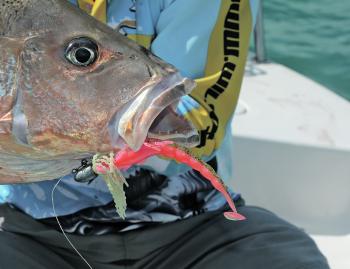
A close up of the lure doing damage right now.
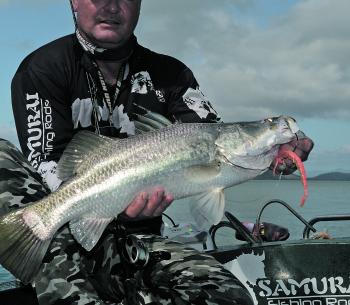
It seems that the Halco Paddle Prawns are extremely effective on a range of species. Unsurprisingly, barra love 'em.
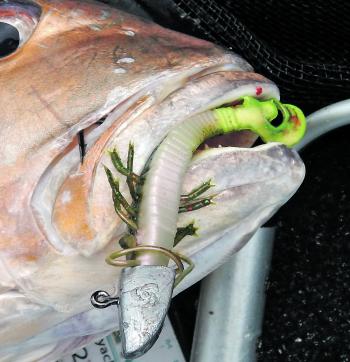
The 4" Atomic Prongs are a good choice when the choppers are shy, but showing on the sounder. Dipping the tail in Quick Coat helps.
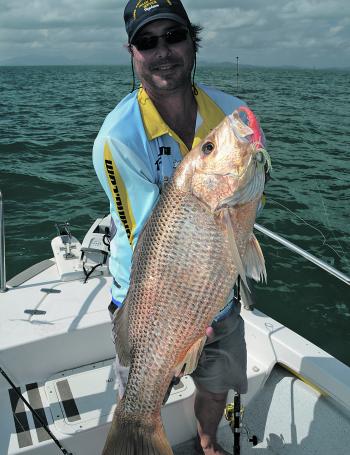
This excited the author in the lead up to the Paddle Prawn’s release – big choppers on plastics. Karl Ramano caught his best soft plastic chopper on his second cast after chasing one for a long time. The glow skirt no doubt has an impact.
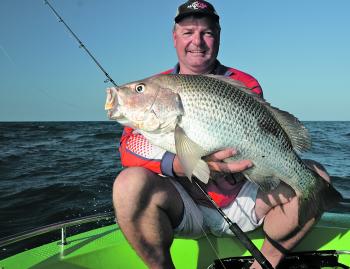
Sometimes you have to prepare for whoppers. The Samurai 20-30lb rod paired up with a Shimano Rarenium and spooled with 50 Unitika Braid is the author’s ‘elephant’ outfit.
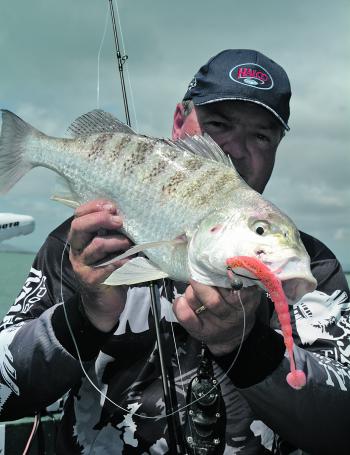
A welcome surprise in the sticks, this nice grunter really gave it to the author on a new 7” Paddle Prawn meant for barra.




